Family : Sphyraenidae

Text © Giuseppe Mazza

English translation by Mario Beltramini
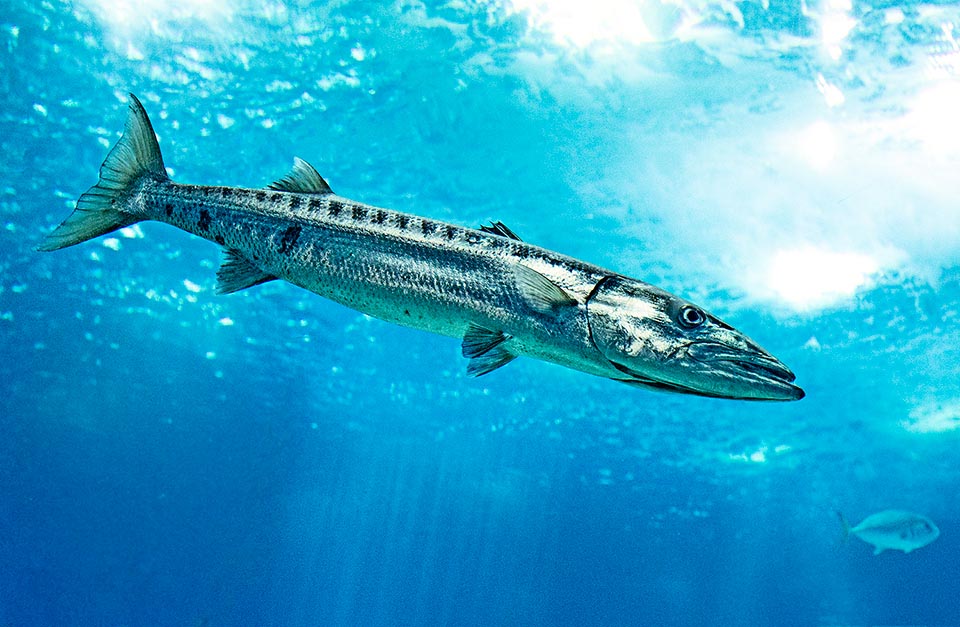
The Great barracuda, Sphyraena barracuda is present in the tropical and subtropical seas of all world, except eastern Pacific © Giuseppe Mazza
The Great barracuda Sphyraena barracuda (Edwards, 1771), belongs to the class of the Actinopterygii, the ray-finned fishes, to the order of the Perciformes and to the family of the Sphyraenidae, that is reserved, rightly, to the barracudas. Fishes that existed already in the Lower Eocene, more than 40 million years ago, nowadays present with only one genus, the Sphyraena, and 28 species.
Initially, the fish had been classified as Esox barracuda Edwards, 1771 due to a certain resemblance with the Pïke (Esox lucius, Linnaeus 1758).
The genus Sphyraena, assigned later, has unclear origin. In Greek, “σφυρά” (sphyra) means hammer or fluke of an anchor, and it appears difficult to associate these terms to this fish. However, the term had already been used by Linnaeus with Esox sphyraena Linnaeus, 1758, nowadays synonym of the European barracuda (Sphyraena sphyraena). Therefore, this is the possible source of inspiration.
Conversely, the etymology of the specific term barracuda is quite simple: it comes from the Spanish term “barraco”, meaning “overlapping teeth”.
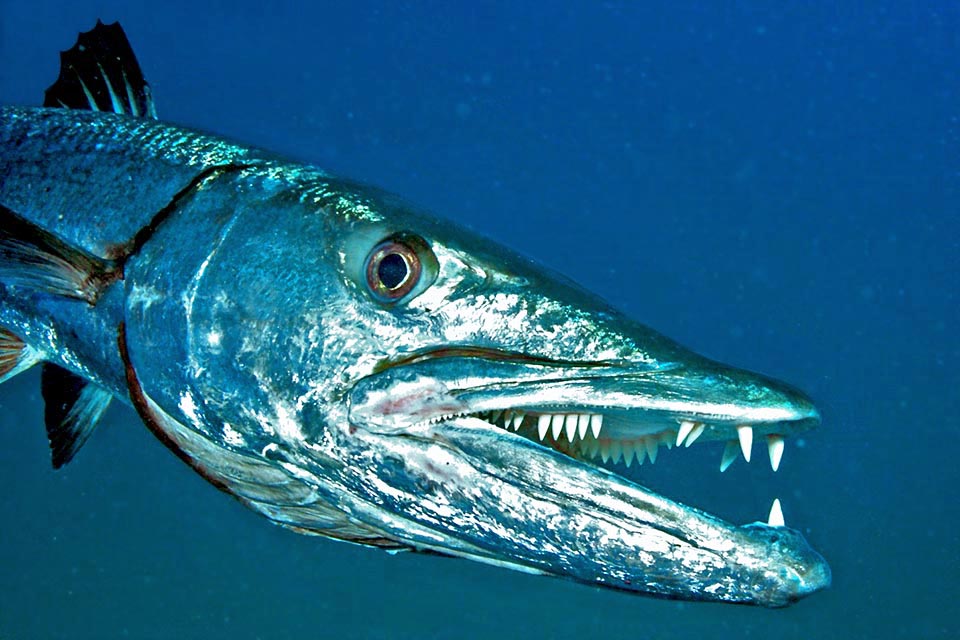
Fusiform, with pointed snout and protruding lower jaw, it can reach the length of 2 m and 50 kg of weight. The enormous mouth, often kept half-open in a threatening smile, occupies about half of the body. It has 2 dorsal fins very distant each from each other. The first one, triangular, is black, often invisible because kept folded while swimming © Allison & Carlos Estape
Zoogeography
The Great barracuda is present in the tropical and subtropical seas all over the world, but central Pacific, where it suddenly stops after having reached Hawaii, the Marquises Islands and the Tuamotu archipelago. This, probably, because its eastwards advance is discouraged by the polar currents of cold water moving towards the Equator.
Sphyraena barracuda is present in the Red Sea and after some it should have already entered the Mediterranean, colonizing the Gulf of Genoa. It could happen, but, for the moment, in 2020, in the eastern Atlantic it has stopped in Mauritania and is not present along the coasts of Morocco and of Spain.
On the other side of the Atlantic Ocean, starting from Massachusetts, it reaches the Gulf of Mexico and is relatively common in the Caribbean Sea and along the coasts of Brazil.
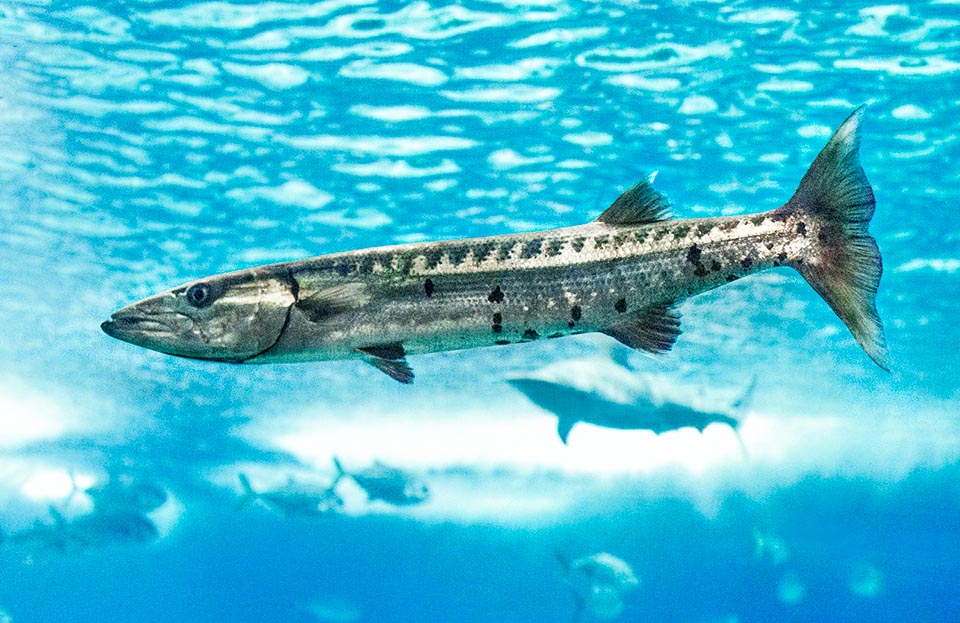
The adults swim almost always isolated. The silvery livery has a characteristic pattern with dark oblique bars over the lateral line and showy black dots below © G. Mazza
Ecology-Habitat
It is a species frequenting various environments, usually swimming along the coasts at 3-30 m of depth, but it may be found in very shallow waters and can go down up to about 100 m and hunt in brackish waters at the mouth of the rivers. The young individuals often grow sheltered by the intricate mangrove formations or hidden in the underwater prairies, whilst the adults prefer the madreporic environments and reproduce offshore, in the open sea.
Morphophysiology
Sphyraena barracuda can be 2 m long and get a weight of 50 kg, even if usually it measures 1-1,4 m. The body is fusiform with pointed snout and protruding lower jaw. The huge mouth, often half open in a sort of a threatening smile, occupies about half of the head, reaching the height of the eyes. It is armed, on the sides, with two rows of sharp teeth, with the addition of 5 long, scaring, canines on the upper jaw and one at the centre of the lower one.
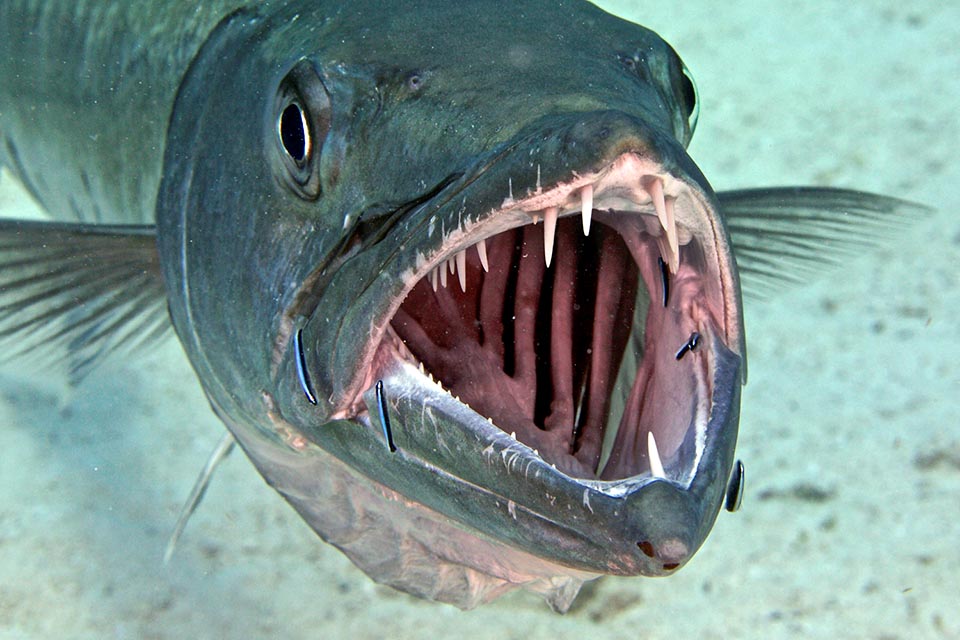
Relaxed specimen with wide open mouth while some wrasses free it from the parasites. We note 5 long canines on the upper jaw and one at the centre of the lower one © Allison & Carlos Estape
Besides their size, the adults distinguish easily from the other species of barracudas due to their behaviour. As a matter of fact, they never gather in dense schools, and the adults go swimming, quite always, alone. The silvery livery, moreover, exhibits a characteristic pattern with oblique dark bars over the lateral line and showy black dots below.
The two dorsal fins, very distant from each other, count totally 6 spiny rays and 9 soft. The first, triangular, is black, often invisible because folded while swimming; whilst the second, of the same size, is more squared, placed over the anal with 2 spiny rays and 8 unarmed. The pelvic fins display one spine and 5 soft rays; the pectoral ones have 13-15 rays, but the driving force, that which allows sudden accelerations, up to more than forty kilometres per hour, is granted by the vigorous forked tail, typical of the fast swimmers. It is black, with a couple of big lobes, and has white tips.
The juvenile livery displays showy mimetic patterns, for defense and for hunting in ambush, as since the beginning this fish is a valiant predator. At such a point that in the stomach of a post-larval specimen, only 5,5 mm long, have been already found small fragments of fish.
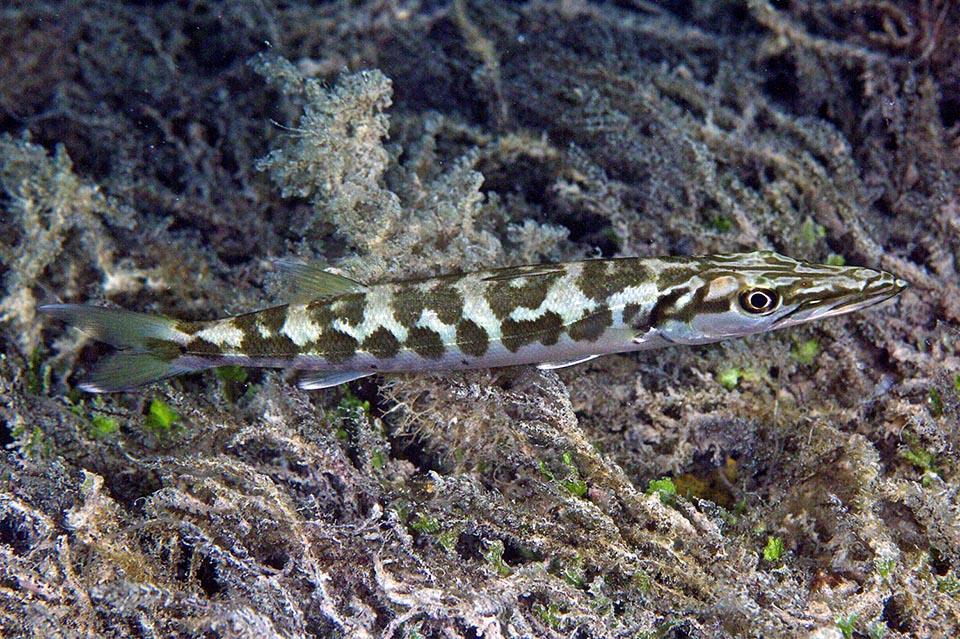
Juveniles grow sheltered by intricate mangrove formations or hidden in the seagrass meadows. They have a mimetic livery very different from the adult one, that appears when about 80 cm long. They predate juvenile schools of atherinidae, sardines, shads or herrings, and some small benthic species such as gobies © Allison & Carlos Estape
With these dimensions, the snout is short with huge eyes and small teeth that are already well visible on both jaws. The body shows a slight messy dotting and there is only one dorsal fin. The second one appears when about 12 mm long, when the pelvic fins appear and the spots thicken in one dark band under the lateral line. When about 20 cm long, the tail has pointed lobes and the snout has remarkably elongated with the protruding lower jaw. The dark band has broken leaving room to a livery with big spots and well marked drawings, quite different from those of the adults that appear only when about 80 cm of size.
Ethology-Reproductive Biology
The diet of the Great barracuda changes with age. Initially, it nourishes mainly of larvae and then preys on juvenile schools of atherinidae, sardines, shads, herrings, plus some small benthic species like the gobies. During this phase the invertebrates form less than the 4% of the diet, but when three years old, the fish swims in madreporic environments, the diet enriches of cuttlefishes, squids, crustaceans and bigger fishes, such as mackerels, scarids, carangids and groupers. In some locations the tetraodontids are very preyed and seen that they are fishes full of tetrodotoxin, a poison 100 times stronger than the cyanide, the flesh of the Great barracuda may become improper for human feeding.
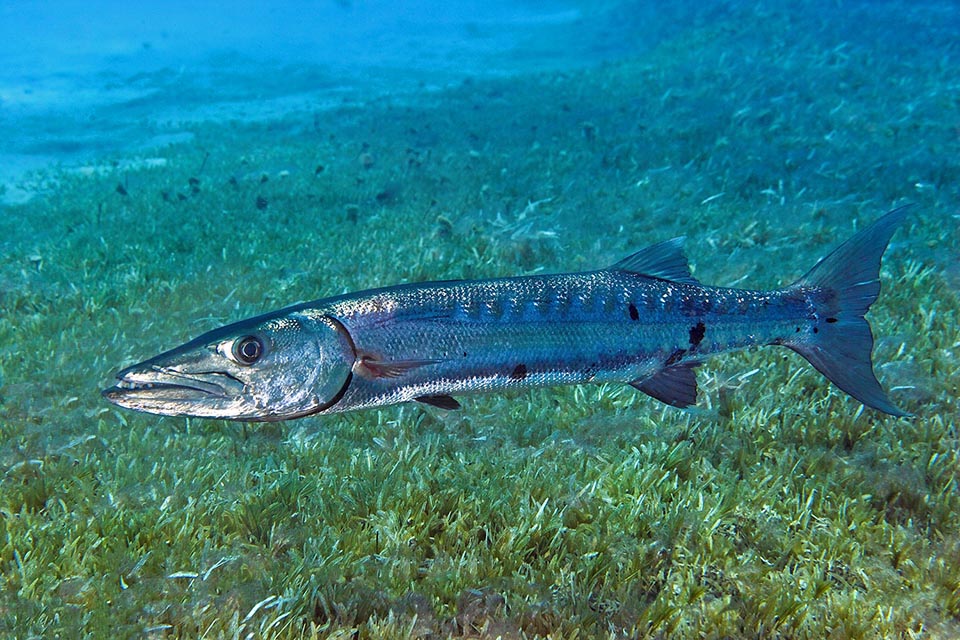
When preying poisonous species, the flesh is improper for human feeding. At times it can bite the divers, mistaking the glinting of knife or bracelets for bluefish © Allison & Carlos Estape
Luckily, the fatal instances are relatively rare, as well as the attacks to swimmers or divers. In such cases, besides the smell of blood associated to the fast movements of a harpooned animal, it seems that they are attracted by the glittering of metallic objects such as rings, bracelets, watches and diving knives, objects they mistake for bluefishes, especially in the murky waters or during the night dives.
Sphyraena barracuda can live even 15 years. It reaches sexual maturity when 50-60 cm long, when 2 years old for the males and 5 for the females. Thousands of eggs are fecundated offshore, where the oceanic currents meet the coastal ones, carrying them in all directions. Also the larvae and the first juvenile phases are pelagic. Then the young barracudas reach the coasts in small schools.
The resilience of the species is decidedly low, as are needed 4,5-14 years to double the populations decimated by the events. It is already scarce in Florida, and the fishing vulnerability index is very high, marking 79 on a scale of 100.
Sphyraena barracuda appears in the Red List of endangered species as “Least Concern“.
Synonyms
Esox barracuda Edwards, 1771; Sphyraena sphyraena picuda Bloch & Schneider, 1801; Sphyraena picuda Bloch & Schneider, 1801; Sphyraena becuna Lacepède, 1803; Sphyraena commersonii Cuvier, 1829; Sphyraena dussumieri Valenciennes, 1831.
→ For general information about FISH please click here.
→ For general information about BONY FISH please click here
→ For general information about CARTILAGINOUS FISH please click here.
→ To appreciate the BIODIVERSITY of BONY FISH please click here.
→ To appreciate the BIODIVERSITY of CARTILAGINOUS FISH please click here.
